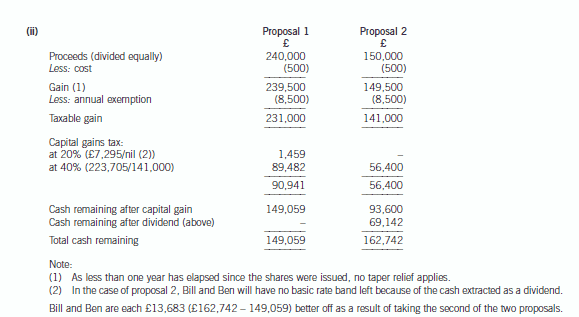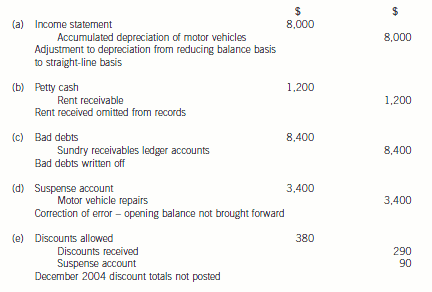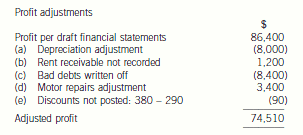acca考试的十四门考试分别是哪些啊?
发布时间:2021-03-11
acca考试的十四门考试分别是哪些啊?
最佳答案
ACCA目前的科目设置如下,共16门(学员需通过12门必修科目及2门选修科目共14门课程)
1.知识课程FUNDAMENTALS--KNOWLEDGE F1会计师与企业Accountant in Business(AB) F2管理会计Management Accounting(MA) F3财务会计Financial Accounting(FA)
2.技能课程FUNDAMENTALS—SKILLS F4公司法与商法Corporate and Business Law(CL) F5业绩管理Performance Management(PM) F6税务Taxation(TX) F7财务报告Financial Reporting(FR) F8审计与认证业务Audit and Assurance(AA) F9财务管理Financial Management(FM)
3.职业核心课程PROFESSIONAL—ESSENTIALS SBL战略商业领袖Strategic Business Leader SBR战略商业报告Strategic Business Reporting
4.职业选修课程PROFESSIONAL--OPTIONS(四门任选二门) P4高级财务管理Advanced Financial Management(AFM) P5高级业绩管理Advanced Performance Management(APM) P6高级税务Advanced Taxation(ATX) P7高级审计与认证业务Advanced Audit and Assurance(AAA)
下面小编为大家准备了 ACCA考试 的相关考题,供大家学习参考。
(ii) Following on from your answer to (i), evaluate the two purchase proposals, and advise Bill and Ben
which course of action will result in the highest amount of after tax cash being received by the
shareholders if the disposal takes place on 31 March 2006. (4 marks)

(ii) Explain the income tax (IT), national insurance (NIC) and capital gains tax (CGT) implications arising on
the grant to and exercise by an employee of an option to buy shares in an unapproved share option
scheme and on the subsequent sale of these shares. State clearly how these would apply in Henry’s
case. (8 marks)
(ii) Exercising of share options
The share option is not part of an approved scheme, and will not therefore enjoy the benefits of such a scheme. There
are three events with tax consequences – grant, exercise and sale.
Grant. If shares or options over shares are sold or granted at less than market value, an income tax charge can arise on
the difference between the price paid and the market value. [Weight v Salmon]. In addition, if options can be exercised
more than 10 years after the date of the grant, an employment income charge can arise. This is based on the market
value at the date of grant less the grant and exercise priced.
In Henry’s case, the options were issued with an exercise price equal to the then market value, and cannot be exercised
more than 10 years from the grant. No income tax charge therefore arises on grant.
Exercise. On exercise, the individual pays the agreed amount in return for a number of shares in the company. The price
paid is compared with the open market value at that time, and if less, the difference is charged to income tax. National
insurance also applies, and the company has to pay Class 1 NIC. If the company and shareholder agree, the national
insurance can be passed onto the individual, and the liability becomes a deductible expense in calculating the income
tax charge.
In Henry’s case on exercise, the difference between market value (£14) and the price paid (£1) per share will be taxed
as income. Therefore, £130,000 (10,000 x (£14 – £1)) will be taxed as income. In addition, national insurance will
be chargeable on the company at 12·8% (£16,640) and on Henry at the rate of 1% (£1,300).
Sale. The base cost of the shares is taken to be the market value at the time of exercise. On the sale of the shares, any
gain or loss arising falls under the capital gains tax rules, and CGT will be payable on any gain. Business asset taper
relief will be available as the company is an unquoted trading company, but the relief will only run from the time that
the share options are exercised – i.e. from the time when the shares were acquired.
In Henry’s case, the sale of the shares will immediately follow the exercise of the option (6 days later). The sale proceeds
and the market value at the time of exercise are likely to be similar; thus little to no gain is likely to arise.
(c) Discuss the reasons why the net present value investment appraisal method is preferred to other investment
appraisal methods such as payback, return on capital employed and internal rate of return. (9 marks)
(c) There are many reasons that could be discussed in support of the view that net present value (NPV) is superior to other
investment appraisal methods.
NPV considers cash flows
This is the reason why NPV is preferred to return on capital employed (ROCE), since ROCE compares average annual
accounting profit with initial or average capital invested. Financial management always prefers cash flows to accounting profit,
since profit is seen as being open to manipulation. Furthermore, only cash flows are capable of adding to the wealth of
shareholders in the form. of increased dividends. Both internal rate of return (IRR) and Payback also consider cash flows.
NPV considers the whole of an investment project
In this respect NPV is superior to Payback, which measures the time it takes for an investment project to repay the initial
capital invested. Payback therefore considers cash flows within the payback period and ignores cash flows outside of the
payback period. If Payback is used as an investment appraisal method, projects yielding high returns outside of the payback
period will be wrongly rejected. In practice, however, it is unlikely that Payback will be used alone as an investment appraisal
method.
NPV considers the time value of money
NPV and IRR are both discounted cash flow (DCF) models which consider the time value of money, whereas ROCE and
Payback do not. Although Discounted Payback can be used to appraise investment projects, this method still suffers from the
criticism that it ignores cash flows outside of the payback period. Considering the time value of money is essential, since
otherwise cash flows occurring at different times cannot be distinguished from each other in terms of value from the
perspective of the present time.
NPV is an absolute measure of return
NPV is seen as being superior to investment appraisal methods that offer a relative measure of return, such as IRR and ROCE,
and which therefore fail to reflect the amount of the initial investment or the absolute increase in corporate value. Defenders
of IRR and ROCE respond that these methods offer a measure of return that is understandable by managers and which can
be intuitively compared with economic variables such as interest rates and inflation rates.
NPV links directly to the objective of maximising shareholders’ wealth
The NPV of an investment project represents the change in total market value that will occur if the investment project is
accepted. The increase in wealth of each shareholder can therefore be measured by the increase in the value of their
shareholding as a percentage of the overall issued share capital of the company. Other investment appraisal methods do not
have this direct link with the primary financial management objective of the company.
NPV always offers the correct investment advice
With respect to mutually exclusive projects, NPV always indicates which project should be selected in order to achieve the
maximum increase on corporate value. This is not true of IRR, which offers incorrect advice at discount rates which are less
than the internal rate of return of the incremental cash flows. This problem can be overcome by using the incremental yield
approach.
NPV can accommodate changes in the discount rate
While NPV can easily accommodate changes in the discount rate, IRR simply ignores them, since the calculated internal rate
of return is independent of the cost of capital in all time periods.
NPV has a sensible re-investment assumption
NPV assumes that intermediate cash flows are re-invested at the company’s cost of capital, which is a reasonable assumption
as the company’s cost of capital represents the average opportunity cost of the company’s providers of finance, i.e. it
represents a rate of return which exists in the real world. By contrast, IRR assumes that intermediate cash flows are reinvested
at the internal rate of return, which is not an investment rate available in practice,
NPV can accommodate non-conventional cash flows
Non-conventional cash flows exist when negative cash flows arise during the life of the project. For each change in sign there
is potentially one additional internal rate of return. With non-conventional cash flows, therefore, IRR can suffer from the
technical problem of giving multiple internal rates of return.
2 The draft financial statements of Choctaw, a limited liability company, for the year ended 31 December 2004 showed
a profit of $86,400. The trial balance did not balance, and a suspense account with a credit balance of $3,310 was
included in the balance sheet.
In subsequent checking the following errors were found:
(a) Depreciation of motor vehicles at 25 per cent was calculated for the year ended 31 December 2004 on the
reducing balance basis, and should have been calculated on the straight-line basis at 25 per cent.
Relevant figures:
Cost of motor vehicles $120,000, net book value at 1 January 2004, $88,000
(b) Rent received from subletting part of the office accommodation $1,200 had been put into the petty cash box.
No receivable balance had been recognised when the rent fell due and no entries had been made in the petty
cash book or elsewhere for it. The petty cash float in the trial balance is the amount according to the records,
which is $1,200 less than the actual balance in the box.
(c) Bad debts totalling $8,400 are to be written off.
(d) The opening accrual on the motor repairs account of $3,400, representing repair bills due but not paid at
31 December 2003, had not been brought down at 1 January 2004.
(e) The cash discount totals for December 2004 had not been posted to the discount accounts in the nominal ledger.
The figures were:
$
Discount allowed 380
Discount received 290
After the necessary entries, the suspense account balanced.
Required:
Prepare journal entries, with narratives, to correct the errors found, and prepare a statement showing the
necessary adjustments to the profit.
(10 marks)


声明:本文内容由互联网用户自发贡献自行上传,本网站不拥有所有权,未作人工编辑处理,也不承担相关法律责任。如果您发现有涉嫌版权的内容,欢迎发送邮件至:contact@51tk.com 进行举报,并提供相关证据,工作人员会在5个工作日内联系你,一经查实,本站将立刻删除涉嫌侵权内容。
- 2021-05-09
- 2021-03-11
- 2021-03-10
- 2021-03-10
- 2021-06-09
- 2021-03-12
- 2021-03-12
- 2021-03-11
- 2021-03-12
- 2021-03-12
- 2021-03-11
- 2021-05-06
- 2021-03-12
- 2021-06-10
- 2021-03-12
- 2021-01-02
- 2021-03-11
- 2021-03-11
- 2021-05-27
- 2021-03-11
- 2021-04-16
- 2021-04-17
- 2021-06-29
- 2021-03-10
- 2021-04-15
- 2021-03-10
- 2021-07-19
- 2021-01-02
- 2021-03-12
- 2021-03-12